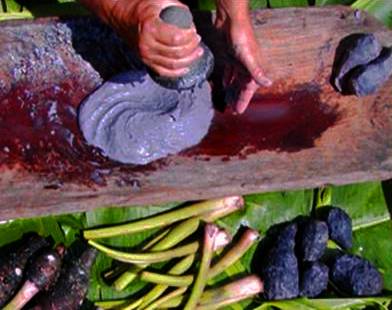Colocasia Esculenta or Simply Taro.
Taro Silkened

Green and heartshaped, means love, life, giving...perhaps a healing, so does nature speak to us?
In Hawaii, the extraordinary value of Taro is manifest in its numerous important roles: as a staple food, as a figure of legend and as a symbol of cultural identity. It is a progenitor of native Hawaiian culture and an ancient crop that is literally part of the Hawaiian people.
Called Taro, Imperial Taro, Colocasia Esculenta, or Antiquorum, it is considered a "sacred' plant in the Island of Hawaii. It is not mere food, nor a favorite subject painted or photographed by Hawaii's beloved artists and photographers. Taro is important to the Hawaiians, with it's mythic tradition, and for other various reasons, which is why there is a drive to preserve and promote Taro cultivation. . According to Hawaiian legend, Taro has divine origins. The first child of two gods, Wakea and Ho'ohokukalani, was stillborn. Following his burial, the baby's body transformed into the first Taro plant. The second son of the gods, called Haloa, is said to be the father of all native Hawaiians.
As an artist, i have been very fascinated by the Taro plant ever since i came to the Islands. I have known it only to be 'food' where i come from, and not a sacred plant that holds so much meaning to the Hawaiian people. Having seen more of it, not just in gardens, but in art galleries, i have a greater appreciation of what the Taro is all about. In fact, i find myself, completely captivated. I love it's lovely heart shaped leaf, and if one were to look up close, it's as if, there is a face. The leaf blades can be green, purple or mottled. As an artist, i have taken my licence to work with this intriguing subject, and somehow, has uncovered how much more there is to her nature, and incredible beauty. What a delight! The normal eyes see leaf stems (petioles) green, reddish, black or variegated. I've seen more. Notice, the top of the leaf stem is bent so the leaf tips point down, one must wonder if plants have their own language. After all, they are 'alive', There are nearly 300 forms of Hawaiian taro that have been recorded, with differences based on size, shape, color of leaf and stem, and flowers. The flowers are small and clustered on fleshy tubular spike with sterile at tip and middle, fertile male between and female below.
Recently, there has been a resurgence of interest in Taro's nutritional and cultural value. worldwide. Food global production has had some unexpected negative effects on health. Diseases formerly associated with the diets of wealthier, developed regions—diets high in processed foods and often low in diversity—have grown in prevalence in developing countries. The Pacific region is not exempted on this trend, with diabetes and obesity, in particular, affecting increasing numbers of people. The reintroduction of Taro and other nutritious traditional foods has been hailed as a potential solution to the region's worsening health.
Taro Farming
Taro Staple
Click thumbnail to view full-size


Beyond Food
Taro functions primarily as a food source. Practically the entire plant is edible. The leaves are cooked and eaten like spinach. The stems are placed inside laulaus to keep the meat moist. Occasionally Taro was substituted for fish offerings at various shrines. Medicinally the raw corm shavings were mixed with other plants and the juice was ingested to treat constipation and indigestion. The raw leaf stems were used to relieve the pain and prevent swelling from insect stings and bites and the leaves were used to treat asthma.
Taro leaves are rich in vitamins and minerals, and a good source of thiamin, riboflavin, iron, phosphorus, and zinc, and a very good source of vitamin B6, vitamin C, niacin, potassium, copper, and manganese. Nowadays Taro products are available in all large American supermarkets. These include Taro chips, Taro bread, Poi, cheesecake, Taro pan, Taro English muffins and Kulolo. Taro is also highly digestible and is bottled as baby food. Although as consumers, we lack the history and culture to appreciate this amazing plant, we can appreciate the delicious products made possible by Taro.
As for me, i plan to enjoy my little green romance and continue to 'immortalize' her loveliness and character, as long as she allows me. Already, Hawaii's fashion icon lady Mamo Howell had taken notice of one of my work, and i have agreed to let her company, by special arrangement, print it in her signature fabric. The clothesline is now out in the market, and may expand to other accessories, such as beach bags, etc. Now you know why i heart Taro. Taro's loving back on me already!.
Taro's of my Heart















